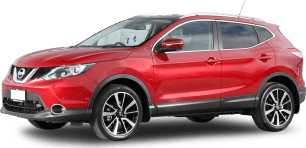When it comes down to it, price is important - so here's a price list of how much each version of the Tucson range will cost you. Note: these are the prices before on-road costs (RRP), not the drive away price. Check our Tucson listings for great deals.
Pricing starts at $28,150 for the entry-level Go 2.0-litre four-cylinder six-speed manual front-wheel drive (FWD) model, which replaces the previous base-model Active at a $440 saving.
The Go can be equipped with the 2.0-litre petrol and a six-speed automatic (FWD) at $30,650, or with a 136kW/400Nm 2.0-litre turbo-diesel eight-speed auto at $35,950.
The Go has standard features such as 17-inch steel wheels with a full-size spare, a 7.0-inch touchscreen media system with six speakers, a reversing camera, Bluetooth connectivity, a single USB port up front, Apple CarPlay (for your iPhone) and Android Auto smartphone mirroring, a digital driver information screen with digital speedometer and trip computer, cruise control, manual air conditioner controls, front fog-lights, roof rails, auto projector halogen headlights and LED daytime running lights.
The range then steps up to the Active X, available as a 2.0-litre FWD manual from $31,350, with a 2.0L FWD six-speed auto at $33,850, or in 2.0-litre diesel AWD form for $35,950.
The Active X gains 17-inch alloys with a matching spare tyre, tyre pressure monitoring, rear parking sensors, 8.0-inch multimedia touchscreen with built-in sat nav, DAB / DAB+ digital radio, eight-speaker sound system with subwoofer, leather seats, two-way electrically adjustable driver's seat with electric lumbar adjustment, heated and folding exterior mirrors, and front and rear USB power outlets.
This model also requires buyers to add the 'SmartSense' safety pack at a cost of $2200, but at least Active X buyers will know their GPS navigation system will get upgrades every time the car is serviced. Read more about ownership below.
The Elite is auto-only: the FWD 2.0L petrol lists at $37,850, or you can have it with a 1.6-litre turbo-petrol with all-wheel drive (AWD) and a seven-speed dual-clutch auto for $40,850, and the diesel-auto-AWD version is $43,850.
The Elite moves up to 18-inch alloy wheels, adds a fully powered driver's seat, smart key (not the full keyless entry set-up - you still need to push a button on the door handle) and push-button start, rain-sensing wipers, tinted windows and rear park assist as well as various aesthetic touches. This spec still has projector halogens - not even HID or xenon lamps, which is disappointing at this price tag.
Top of the range is the automatic and AWD only Highlander. It can be had with the turbo-petrol auto AWD at $46,500, or with the diesel AWD auto at $48,800. It's the premium package, if that's what you're into.
The Highlander comes equipped with 19-inch alloy wheels, LED headlights (which would be welcome in grades below!) and LED tail-lights, front park assist, panoramic sunroof, power passenger seat, heated front seats and a heated steering wheel, powered tailgate, 4.2-inch colour LCD screen in the dash, wireless phone charging, dimming rear mirror and various aesthetic touches.
Buyers can option both the Go and Active X models with the SmartSense safety pack at a cost of $2200, and that brings not only extra high-tech safety gear, but some additional desirable equipment, too.
The pack - which is fitted to Elite and Highlander models as standard - brings blind spot monitor (also known as lane change assist), driver attention warning, forward collision warning with pedestrian detection, auto emergency braking (AEB), lane departure warning with active lane keep assist (with power steering intervention), rear cross-traffic alert and adaptive cruise control (which works down to 0km/h).
That's on top of a traction control system with ESP, hill start assist, and hill descent control - but there's no differential lock, even on the AWD models. It also adds dual-zone climate control, a cooled glove box, electric park brake, electric folding and heated side mirrors, and puddle lamps to the base two grades.
While we don't control your purse strings, a quick glance at the models suggests it'd be a hard choice in this model comparison: Active X 2.0-litre auto with the safety pack vs the Elite 2.0-litre auto.
No model comes with a CD player, and while the infotainment system is good, its multimedia capabilities don't extend to a DVD player, either. The tech gadgets don't include 'Homelink', either (some US market models can get this smart garage door opening system).
Unlike some brands, there's no launch edition - but the company has hit showrooms with attractive drive-away prices on lower grade variants. And there's a chance an N-Line sport edition may show up before this generation model is replaced.
As for accessories, we reckon you could argue with the dealer to throw in a set of floor mats on all trim levels, and you might be able to swap rims if you ask nicely, too. If you're thinking of a light bar, bullbar, nudge bar or snorkel you might need to go to an aftermarket parts specialist.
As for colours, the Go model is available with five options: 'Aqua Blue', 'Pepper Grey', 'Phantom Black', 'Platinum Silver' and 'Pure White'. Active X and Elite models add two more options - 'Gemstone Red' and 'Sage Brown'.
The Highlander has all of the above, and adds 'Dusk Blue' and 'White Pearl'. There is no green or orange available, but you can get beige leather trim on the three higher grade models ($295).
How many seats in the Tucson? Only five. If you need seven, you ought to check out the very impressive Santa Fe model.





.png)










































.png)





















 copy.png)














